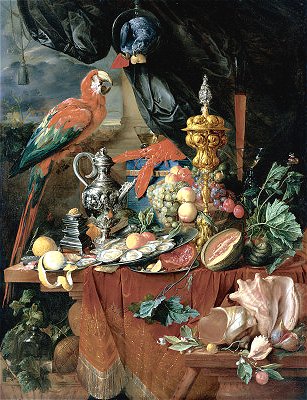
Click pic to enlarge |
|
website by Willem van Osnabrugge
Still Life with Parrots
Jan Davidz. de Heem Dutch 1606-1684
SN 298. Oil on Canvas late 1640's
Artist:
Jan Davidz. de Heem was born in Utrecht into a large family
of painters, but spent most of his life in Antwerp. He was highly renowned during his
lifetime for exquisitely rendered and lavish still-life pictures - even his contemporary
competitors saw him as something of a marvel. Nearly all still-life painters that followed
de Heem were affected by his work and many tried to imitate his work. He is considered
today to be one of the most eminent still-life painters of the 17th century and his
pictures are among the most expensive Dutch paintings.
The artist began his career in Leiden painting Vanitas
still lifes, which admonish the viewer to remember the transience of life and the
worthlessness of earthly pleasures. In 1635 he moved to Antwerp where he painted pictures
which synthesized the flamboyant Flemish tradition with the Dutch "pronk", or
fancy still life, into a unique style that became influential in both countries. This
mature manner was formed in the years 1640-42 and varied little thereafter. The works for
which he is most renowned are those done in Flanders - splendid flower pieces and
exquisitely laid tables which "breathe" an opulent exhuberance of Femish Baroque
painting. |
De Heem's sumptuous still-lifes included precious objects such as gold and
silversmith's work, Venetian glass and exotic shells besides fruit and other food. The
meaning of several of his paintings was made explicit by inscribed texts, usually
referring to vanitas and Christian symbolism. His compositions were given depth by means
of architectural features in back and foreground and thru effects of highlights and
shadows. He often used delicate glazes and concenrated a shimmering light on essential
objects.
Subject:
This painting presents a rich accumulation of natural objects most of which were not
indigenous to the Netherlands : an African gray parrot, a scarlet macaw from Brazil,
exotic fruits from southern climes and rare sea shells from the East and West Indies. In
addition the painting shows off works of man : a tall elegant flute glass, a richly
decorated silver ewer, and a magnificent standing gilt goblet.
Like other de Heem paintings, Still Life With Parrots has been thought to
contain a complex symbolism centering on the themes of temperence and the vanity of
earthly pleasures. The gold and silverware and the shells allude to the vanities of
collecting & spending money on costly, worldly goods. Other elements admoniosh the
beholder against overindulgence - for example melons, thought to produce insanity ;
oysters leading to sexual excess, and the lobster which symbolized instability.
Another interpretation is that of steadfastness symbolized by the unbroken
column (spiritual strength) ; that of salvation symbolized by the bread, wine and grapes (
Eucharistic associations) and by the parrots which symbolize man in his praise of God.
Other interpretations have also been supported by various items in the painting including
one view that the painting has no coherent symbolic program and that the viewer was simply
meant to enjoy a visual feast.
Painting:
This painting is illusionistic in its rendering of textures and the effects of light.
Throughout the picture de Heem presents objects of contrasting scale (the large lobster
and small shrimp), shape (irregular and geometric forms), and texture (feathers with
various metals and shells). The composition is carefully balanced and the color is
contolled to unify the picture. Green in particular becomes more intense the closer it is
used to the center and red is used as a unifying element throughout the composition. In
every instance the objects have been depicted with meticulous attention to visual truth.
Owing to the profusion of forms , its rich coloration and its brilliant effects the
painting has a celebratory air.
There is nothing in the painting to suggest a routine everyday meal, there
are no meats or vegetables. The fruits and nuts are all open, howeve,r and ready to be
eaten as are the glasses filled with wine. All of the signs of abundance, silver and
gilded silver objects etc. are presented in a disordered fashion. This Ringling painting
has overtones of waste and decay, or at least an admonition to be moderate (ex. the Parrot
eating the expensive imported fruit, all the food open and unpeeled ).
The condition of the painting is generally good.
Historical Context:
In the 17th century the Dutch had crushed the Spanish navy in the Battle of the Downs and
had achieved independence. It was the so called Golden Age of the Dutch Republic. The
Dutch merchants expanded their trade in the East and West Indies making Holland a very
wealthy country indeed.
Protestantism was greatly influenced by Calvinism in Holland. While no
historical religious paintings were approved for protestant churches it was acceptable to
commission paintings containing a moral message. Paintings emphasized the country's wealth
while at the same time cautioning against over indulgence or vanity of any kind which
would be seen as unacceptable in the eyes of God.
click here for all Ringling other art |
